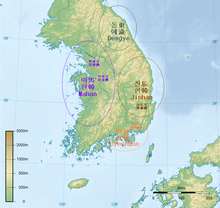
Back سامهان Arabic Samhan Danish Samhan German Samhan Spanish سمهان Persian Samhan French Szamhan Hungarian Samhan ID 三韓 Japanese 삼한 Korean
| Korean name | |
| Hangul | 삼한 |
|---|---|
| Hanja | |
| Revised Romanization | Samhan |
| McCune–Reischauer | Samhan |

Samhan, or Three Han, is the collective name of the Byeonhan, Jinhan, and Mahan confederacies that emerged in the first century BC during the Proto–Three Kingdoms of Korea, or Samhan, period. Located in the central and southern regions of the Korean Peninsula, the Samhan confederacies eventually merged and developed into the Baekje, Gaya, and Silla kingdoms.[1] The name "Samhan" also refers to the Three Kingdoms of Korea.[2]
Sam (三) is a Sino-Korean word meaning "three" and Han is a Korean word meaning "great (one), grand, large, much, many".[3] Han was transliterated into Chinese characters 韓, 漢, 幹, or 刊,[citation needed] but is believed by foreign linguists to be unrelated to the Han in Han Chinese and the Chinese kingdoms and dynasties also called Han (漢) and Han (韓). The word Han is still found in many Korean words such as Hangawi (한가위) — archaic native Korean for Chuseok (秋夕, 추석), Hangaram (한가람) — archaic native Korean for Hangang (漢江, 한강), Hanbat (한밭) — the original place name in native Korean for Daejeon (大田, 대전), hanabi (하나비) — a Joseon-era (Late Middle Korean) word for "grandfather; elderly man" (most often 할아버지 harabeoji in present-day Korean, although speakers of some dialects, especially in North Korea, may still use the form hanabi). Ma means south, Byeon means shining and Jin means east.[4]
Many historians have suggested that the word Han might have been pronounced as Gan or Kan. The Silla language had a usage of this word for king or ruler as found in the words 마립간 (麻立干; Maripgan) and 거서간 / 거슬한 (居西干 / 居瑟邯; Geoseogan / Geoseulhan). Alexander Vovin suggests this word is related to the Mongolian Khan and Manchurian Han meaning ruler, and the ultimate origin is Xiongnu and Yeniseian.[5]
The Samhan are thought to have formed around the time of the fall of Gojoseon in northern Korea in 108 BC. Kim Bu-sik's Samguk Sagi, one of the two representative history books of Korea, mentions that people of Jin Han are migrants from Gojoseon, which suggests that early Han tribes who came to Southern Korean peninsula are originally Gojoseon people; this coincides with the state of Jin in southern Korea also disappearing from written records. By the 4th century, Mahan was fully absorbed into the Baekje kingdom, Jinhan into the Silla kingdom, and Byeonhan into the Gaya confederacy, which was later annexed by Silla.
Beginning in the 7th century, the name "Samhan" became synonymous with the Three Kingdoms of Korea. The "Han" in the names of the Korean Empire, Daehan Jeguk, and the Republic of Korea (South Korea), Daehan Minguk or Hanguk, are named in reference to the Three Kingdoms of Korea, not the ancient confederacies in the southern Korean Peninsula.[2][6]
- ^ Injae, Lee; Miller, Owen; Jinhoon, Park; Hyun-Hae, Yi (2014). Korean History in Maps. Cambridge University Press. p. 18. ISBN 9781107098466. Retrieved 16 April 2019.
- ^ a b 이기환 (30 August 2017). [이기환의 흔적의 역사]국호논쟁의 전말…대한민국이냐 고려공화국이냐. 경향신문 [Kyunghyang Shinmun] (in Korean). Retrieved 2 July 2018.
- ^ Naver Korean dictionary
- ^ Lu Guo-Ping. 在韓國使用的漢字語文化上的程 [A Historical Study on the Culture in Chinese Characters in Korea] (PDF) (Thesis) (in Chinese). Archived from the original (PDF) on 2011-07-22.
- ^ Vovin, Alexander (2007). "Once again on the etymology of the title qaγan". Studia Etymologica Cracoviensia. 12: 177–187.
- ^ 이덕일 (14 August 2008). [이덕일 사랑] 대~한민국. The Chosun Ilbo (in Korean). Retrieved 2 July 2018.
© MMXXIII Rich X Search. We shall prevail. All rights reserved. Rich X Search